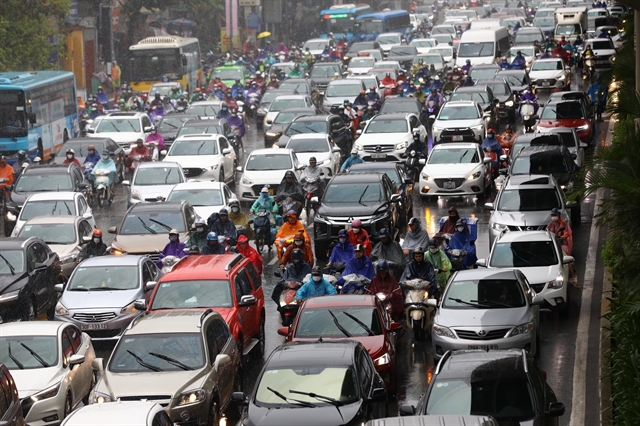 Society
Society

 |
| Traffic congestion on Nguyễn Trãi Street, Thanh Xuân District in Hà Nội on August 11.— VNA/VNS Photo Huy Hùng |
HÀ NỘI — In a bid to ease traffic congestion and reduce pollution in Hà Nội, around 100 automatic toll stations for cars entering the city’s inner areas could be set up over the next three years.
The plan was revealed at the project “Collecting toll for cars entering Hà Nội’s inner areas to reduce traffic congestion and pollution”, which recently has been supplemented by the Hà Nội University of Transport and reported to the Hà Nội’s Transport Department.
A representative of the project’s consulting group told Tiền Phong (Vanguard) online newspaper that currently, Hà Nội has many more routes connecting to the inner areas than it did two years ago.
Therefore, the number of toll stations also needs to increase, he said.
Under the project, by 2025, the area determined to set up the toll stations is within the Ring Road No 3.
All cars moving from outside the Ring Road 3 into the city’s inner areas have to pay tolls.
Some cars will be exempted from paying the tolls, including priority vehicles, police cars, military vehicles, ambulances, fire trucks; official vehicles; and buses.
The group of vehicles eligible for fee reduction includes cars of public utility companies; vehicles engaged in passenger transport businesses; vehicles transporting goods; cars less than nine seats of households living in toll-collection areas, and cars belong to offices located within toll-collection areas.
The tolls are determined at VNĐ50,000-100,000 (US$2-4) per vehicle. The time to collect the tolls is between 5am and 9pm.
The total investment for the establishment of a toll station system is estimated at VNĐ2.6 trillion ($106 million).
The project will apply non-stop toll collection technology. This form of toll collection is a combination of Radio Frequency Identification (RFID) and Automatic Number Plate Recognition (ANPR) through an automatic surveillance camera system to detect non-paying vehicles, serve toll collection and handle non-payment of tolls.
The project’s consulting group said when applying to collect the tolls, it is expected to reduce 20 per cent of traffic flow going into the inner areas, thereby reducing traffic congestion.
The consulting group said that if collecting a toll of VNĐ50,000 ($2) per car, costs of investment, management and operation will be covered.
With a fee of VNĐ100,000 ($4) per a car, there will be an annual budget revenue of about VNĐ300 billion ($12.2 million) per year.
Data from the transport department shows that Hà Nội currently has around 6.4 million vehicles, 5.6 million of which are motorbikes. There are around 600,000 cars, plus another two million other vehicles, from outside Hà Nội.
Experts’ comments
Chairman of the Việt Nam Automobile Transport Association (VATA) Nguyễn Văn Quyền said that collecting tolls to reduce traffic congestion is a must.
However, it is not simple to deploy the project. Public transport is required to meet the travelling demand of the people, he said.
For example, the metro and bus systems in the city must meet 50-60 per cent of people's travel demand to encourage them to switch from private cars to public vehicles, he said.
But the current capacity of public transport in Hà Nội now fails to do that, he said.
Khương Kim Tạo, former deputy chief of the National Committee for Traffic Safety’s Office said it is a right policy, but it must be calculated and the difficulties that may occur when we implement the project must be thoroughly acknowledged.
First of all, we should have a pilot survey and then have an assessment before expanding, he said.
For example, the city now has two roads of Lê Văn Lương and Nguyễn Trãi, which are heavily congested each day, he said.
It should pilot to collect fees at these two roads and then make calculations of the effectiveness before applying the project, he said.
When public transportation is not convenient, people will still have to use private cars, he said.
But not everyone is willing or able to pay tolls. At that time, people will avoid to travel on big roads with toll stations, they will travel on small roads, increasing traffic congestion on the roads, he added.
People will have a tendency to buy houses or apartments inside the Ring Road No 3 to avoid having to pay regular and long-term tolls, he added.
And with more people living inside of the Ring Road No 3. traffic congestion in the city’s inner areas will increase.
Phan Lê Bình, a traffic expert told Tuổi trẻ (Youth) online newspaper that currently, most of cars in Việt Nam have been equipped with automatic toll payment tags (e-tag), making them eligible to use the electronic toll collection (ETC) system.
So, if the project is implemented, it should integrate into the ETC card, it does not need another card, he said.
Using another card will be inconvenient and cause more troubles for people and businesses, he said. — VNS




